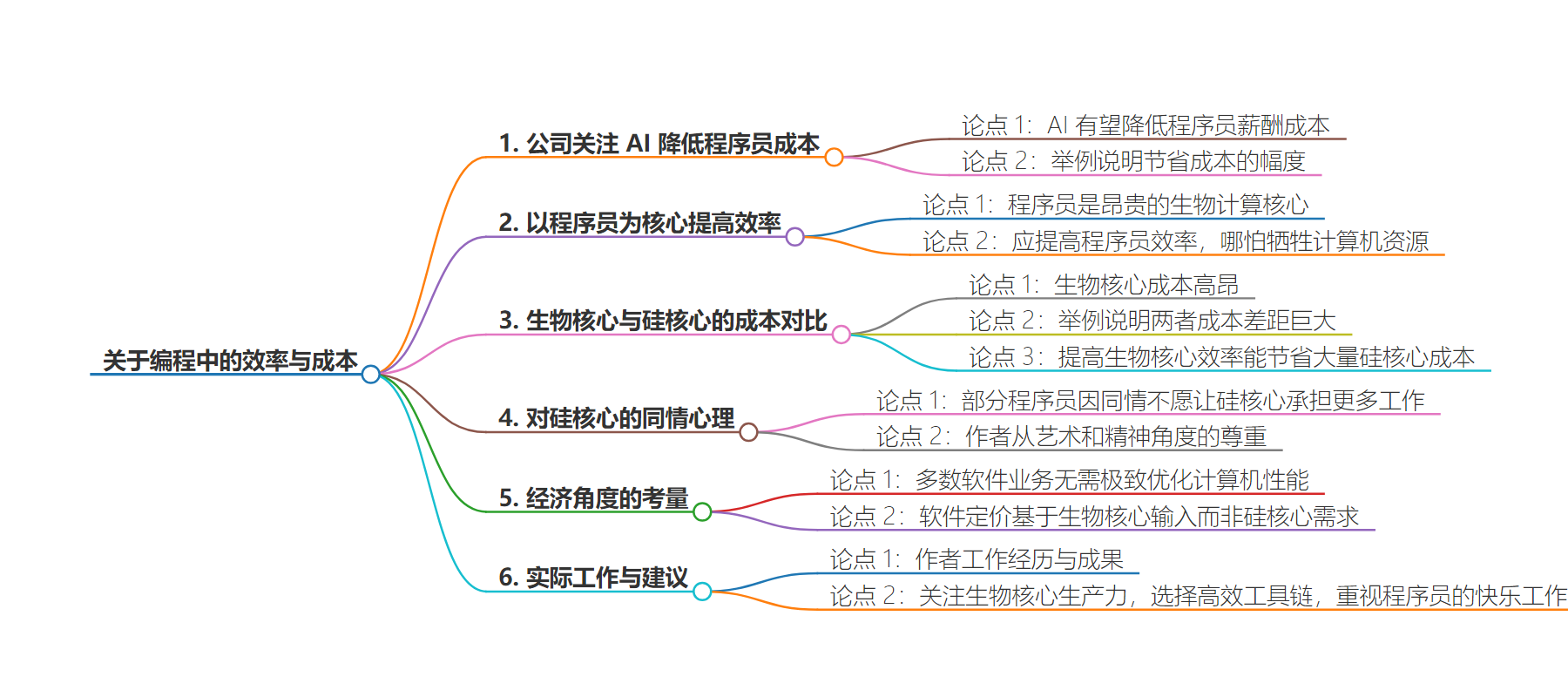包阅导读总结
1. 关键词:AI、程序员、计算效率、生物核心、硅核心
2. 总结:公司关注 AI 因有望降低程序员成本,以 Ruby on Rails 为例说明应让程序员更高效而非节省计算机资源。对比生物和硅计算核心成本,强调应关注生物核心效率提升,多数软件取决于生物核心输入,要选最高效工具链。
3. 主要内容:
– 公司热衷 AI 因其或降低程序员薪酬成本
– 举例说明若能削减程序员数量,可节省大量开支
– 作者对 Ruby 和 Rails 的看法
– 认为应让程序员更高效,哪怕牺牲计算机
– 生物与硅计算核心的比较
– 生物核心昂贵稀缺,硅核心更丰富且成本降低
– 提高生物核心效率能节省大量硅核心成本
– 关于程序员对计算核心的态度
– 部分程序员因同情硅核心而不愿提升自身效率
– 经济角度与实际工作
– 多数商业软件业务无需极致优化
– 作者专注业务软件制作与销售
– 当下的选择
– 关注生物核心,选高效工具链,让程序员高效工作
思维导图:
文章地址:https://world.hey.com/dhh/optimize-for-bio-cores-first-silicon-cores-second-112a6c3f
文章来源:world.hey.com
作者:David Heinemeier Hansson
发布时间:2024/9/6 15:18
语言:英文
总字数:737字
预计阅读时间:3分钟
评分:87分
标签:AI 与效率,程序员生产力,经济优化,Ruby on Rails,软件开发
以下为原文内容
本内容来源于用户推荐转载,旨在分享知识与观点,如有侵权请联系删除 联系邮箱 media@ilingban.com
A big part of the reason that companies are going ga-ga over AI right now is the promise that it might materially lower their payroll for programmers. If a company currently needs 10 programmers to do a job, each have a cost of $200,000/year, then that’s a $2m/year problem. If AI could even cut off 1/4 of that, they would have saved half a million! Cut double that, and it’s a million. Efficiency gains add up quick on the bottom line when it comes to programmers!
That’s why I love Ruby! That’s why I work on Rails! For twenty years, it’s been clear to me that this is where the puck was going. Programmers continuing to become more expensive, computers continuing to become less so. Therefore, the smart bet was on making those programmers more productive EVEN AT THE EXPENSE OF THE COMPUTER!
That’s what so many programmers have a difficult time internalizing. They are in effect very expensive biological computing cores, and the real scarce resource. Silicon computing cores are far more plentiful, and their cost keeps going down. So as every year passes, it becomes an even better deal trading compute time for programmer productivity. AI is one way of doing that, but it’s also what tools like Ruby on Rails were about since the start.
Let’s return to that $200,000/year programmer. You can rent 1 AMD EPYC core from Hetzner for $55/year (they sell them in bulk, $220/month for a box of 48, so 220 x 12 / 48 = 55). That means the price of one biological core is the same as the price of 3663 silicon cores. Meaning that if you manage to make the bio core 10% more efficient, you will have saved the equivalent cost of 366 silicon cores. Make the bio core a quarter more efficient, and you’ll have saved nearly ONE THOUSAND silicon cores!
But many of these squishy, biological programming cores have a distinctly human sympathy for their silicon counterparts that overrides the math. They simply feel bad asking the silicon to do more work, if they could spend more of their own time to reduce the load by using less efficient for them / more efficient for silicon tools and techniques. For some, it seems to be damn near a moral duty to relieve the silicon of as many burdens they might believe they’re able carry instead.
And I actually respect that from an artsy, spiritual perspective! There
is
something beautifully wholesome about making computers do more with fewer resources. I still look oh-so-fondly back on the demo days of the Commodore 64 and Amiga. What those wizards were able to squeeze out of
a mere 4kb
to make the computer dance in sound and picture was truly incredible.
It just doesn’t make much economic sense, most of the time. Sure, there’s still work at the vanguard of the computing threshold. Somebody’s gotta squeeze the last drop of performance out of that NVIDIA 4090, such that our 3D engines can raytrace at 4K and 120FPS. But that’s not the reality at most software businesses that are in the business of making business software (say that three times fast!). Computers have long since been way fast enough for that work to happen without heroic optimization efforts.
And that’s the kind of work I’ve been doing for said twenty years! Making business software and selling it as SaaS. That’s what an entire industry has been doing to tremendous profit and gainful employment across the land. It’s been a bull run for the ages, and it’s been mostly driven by programmers working in high-level languages figuring out business logic and finding product-market fit.
So whenever you hear a discussion about computing efficiency, you should always have the squishy, biological cores in mind. Most software around the world is priced on their inputs, not on the silicon it requires. Meaning even small incremental improvements to bio core productivity is worth large additional expenditures on silicon chips. And every year, the ratio grows greater in favor of the bio cores.
At least up until the point that we make them obsolete and welcome our AGI overlords! But nobody seems to know when or if that’s going to happen, so best you deal in the economics of the present day, pick the most productive tool chain available to you, and bet that happy programmers will be the best bang for your buck.
